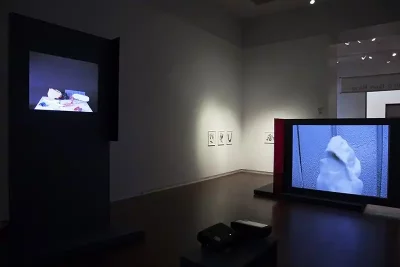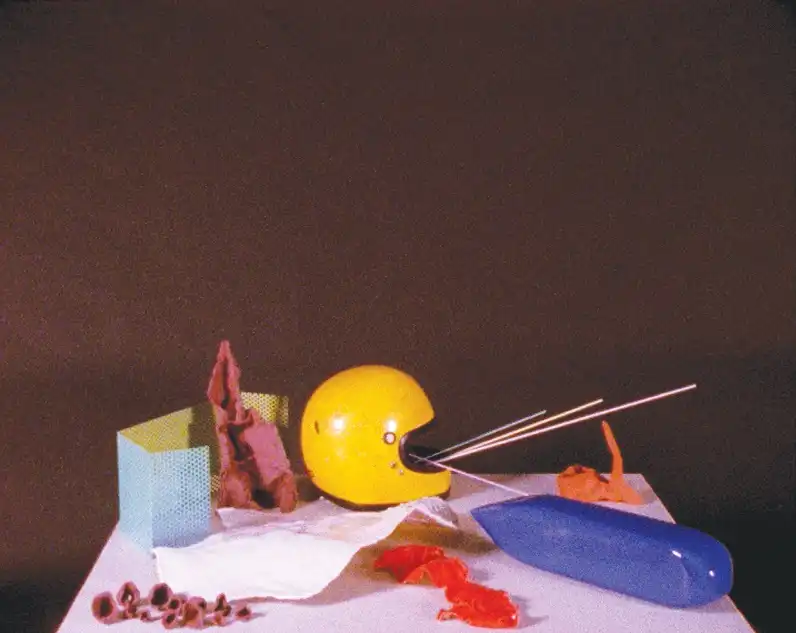salt 6: Emre Hüner
Art
I entered the corner gallery with the museum’s new curator, Whitney Tassie, a recent Salt Lake transplant from Chicago. The Salt Gallery is a cozy, dynamic space reserved for emerging artists like Emre Hüner, aiming “to reflect the international impact of contemporary art today, forging local connections to the global and bring[ing] new and diverse artwork to the city that shares the program’s name,” Tassie says.
Tassie explained to me that Hüner created this video, sculpture and drawing installation specifically for this space. His approach to object making is enthralling, bizarre and poignant. In about 100 square feet, he attempts to dissect modernity, the ideal of utopia, and their falls from grace.
Hüner is from Istanbul, Turkey. During his childhood, the nation faced political tumult through a series of military coups, followed by periods of relative stability. This instability, the sanctified ideals behind these short-lived governments, as well as the artist’s ultimate rejection of them are all built into his object making.
His oeuvres also explore the relationship between the future and the past, between nature and artifice. His themes echo those explored by other artists during the centuries before him, but his interpretation is a vast departure from immense tableaus depicting biblical scenes or from silkscreened commercial images. He is a creation of his time; he is a Cold War baby.
Sometimes, in contemporary art, I find myself exhausted by explanations to make sense of the works in front of me: Their inaccessibility is overwhelming. Although Hüner’s installation is abstract, it’s rooted in the real. His space consists of drawings from his Shrine of the Post Hypnotic series, in addition to two videos, Aeolian Processes #1 and #2.
In Aeolian Processes #2, the shots consist of amorphous objects that are oddly situated against an artificial background. They look consciously contrived, resulting in tension. Sometimes even the natural formations appear artificial. In one still, a silvery-mountain-like object sits atop a spinning, white-metal stand. It resembles the Foothills or some Turkish equivalent.

The background is a stark white, stucco wall. Everything is white or silver except for the shiny, wooden rifle positioned directly behind the spinning mountain. In 2010, Hüner created a piece entitled Vertical Is To Live, Horizontal Is To Die. With the knowledge of this reference, this one moving image is transformed into a loaded statement.
The horizontal clay mountain juxtaposes the vertical rifle. Is this instrument of death the only means of living, of maintaining life? Does artifice trump nature? Or, is he simply remarking on the tension between tradition and the realities of modern life; between the pastoral and the industrial society?
Tassie let me in on an interesting story that guided Aeolian Processes #1. Apparently, Henry Ford, industrial genius and anti-Semite-extraordinaire, designed a South American utopia in Brazil. It was meant to be a rubber plantation/civilizing mission that provided Brazilians with an American culture and quality of living—they weren’t so happy about that.
In the end, his jungle city was a total flop and today stands in ruins. Whitney explained to me that many of the clay formations in Hüner’s film were recreations of the ruins from Ford’s failed community.
The rusty remains from this experiment expose the breakdown of the utoptianist thought. The 20th Century was a series of experiments in new forms of governments and societies. As colonialism crumbled and Communism rose, things fell apart; the center did not hold. Genocides resulted, and today, perhaps we as a world, have no more dreams of perfection.
Hüner’s work is all about societies on the brink, a theme applicable to any country at this point in time. According to Tassie, his “non-linear approach to film and object making investigates problematic political relationships and contentious concepts of modernity without being didactic or authoritative.
His creative mixing of fact and fiction encourages us to question information perceived as standard and developments perceived as beneficial.” Sometimes we feel removed from national and global conflicts. Exhibits like this remind us that in this world, we can never disconnect completely. They remind us of our connection to everyone, be it through nature, through society or through technology.
The next installation in the Salt Gallery is quickly approaching. salt 7: Lynette Yiadom-Boakye will be opening on Thursday, Feb. 21, at 7 p.m. The artist will speak with the curator (Whitney Tassie). The exhibit will remain until June 23. This means free admission next Thursday from 6 – 9 p.m. This will also be Tassie’s first solo-curated exhibit at the UMFA. Check it out!
